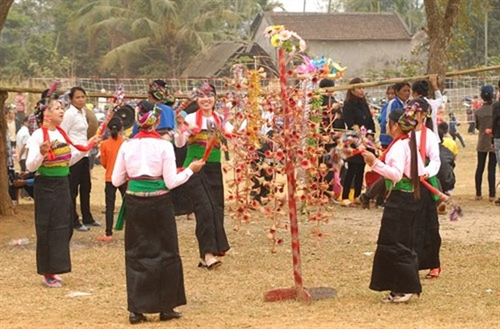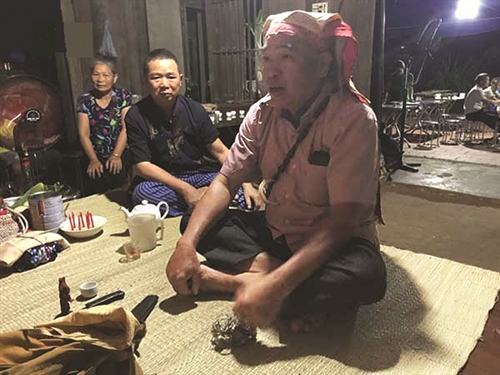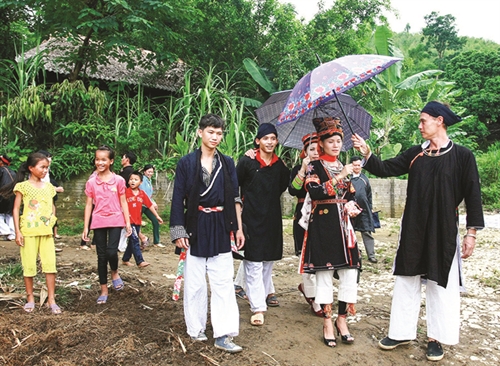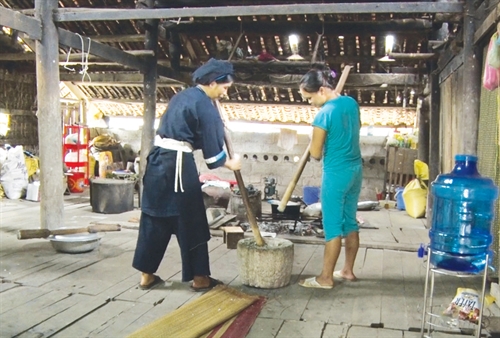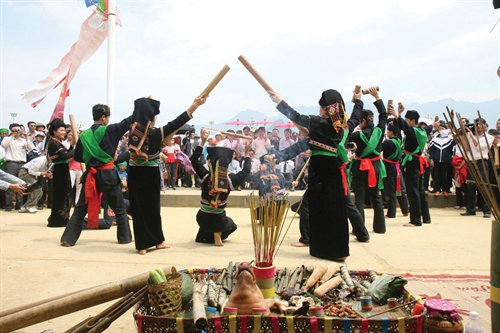Ta Thi Tam, M.A.
Institute of Anthropology
Vietnam Academy of Social Sciences
Located on the left bank of the Red River and about 13 kilometers to the southeast of the capital city, Bat Trang ceramics village in Gia Lam rural district of Hanoi has become one of the country’s famous tourist destinations for its well-known pottery and porcelain products.
It can be said that the founding of Thang Long capital city, the name of Hanoi in the period from the 11th to 14th century, had a great economic impact on the establishment and development of many traditional craft villages, including Bat Trang ceramics village.
Bat Trang villagers believe that their village was established in the Ly dynasty. When King Ly Thai To relocated the capital city from Hoa Lu in the northern province of Ninh Binh to Thang Long in 1010, a number of traders and craftsmen followed him to settle down in the new capital. Among them, some were from Bo Bat ceramics village in Yen Mo district of Ninh Binh province. The potters found several mounds of white clay, the essential material for making ceramics products, in an outskirt area of the new capital city, which is now Bat Trang village, and decided to build pottery kilns there. Thanks to exquisite workmanship and abundant sources of high-quality materials, the village gradually built up its reputation and became a well-known ceramics center of the country.
Products of Bat Trang ceramics village are very plentiful, ranging from crockery and decorative items to ceremonial objects. However, for all types of products, embossed decoration and ivory-white crackle glaze are two characteristics that distinguish Bat Trang pottery from products of other traditional ceramics villages.
The making of ceramics by Bat Trang potters’ traditional technique is a four-step process, including preparing raw materials; shaping clay; decorating and glazing; and firing.
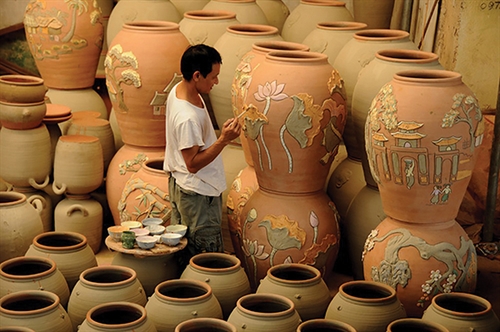 |
| Producing ceramics products by traditional methods in Bat Trang craft village__Photo: https://battrangvn.vn/ |
Preparing raw materials
Clay and glaze are the two materials needed for making ceramic products.
The finding of clay sources is the first thing to do. In the past, Bat Trang potters used locally available clay to make pottery items. As time passed, the local sources of white clay became exhausted and by the 18th century, Bat Trang people had to seek alternatives from surrounding areas. They sailed boats along the Red River and bought clay from different localities, mainly Phung Cong and Dan Nhiem villages in the nowadays Van Giang district of Hung Yen province, Van Loc and Co Dien villages in the present Dong Anh district of Hanoi, and the villages of Tu Lac and Bich Nhoi in the today Kinh Mon district and Truc Thon and Ho Lao in the current Chi Linh district of Hai Duong province.
To prepare earth for making ceramics, potters have to remove impurities from raw materials and apply a suitable method of blending. Bat Trang craftsmen often use four water tanks for earth treatment. At the beginning, raw clay is steeped in water for three or four months in the first tank, called stirring ark, which is placed in the highest position. After three or four months, the earth becomes decomposed and dissolves in water. The slurry is then drained to the second tank, called sedimentation ark or filter ark, which is placed next to the first one at a lower position. In the second tank, clay particles gradually deposit while impurities, mostly organic substances, float on the surface and are later removed. Then, the deposited material is taken to the third tank, called drying ark, and kept there for three to four days. Finally, it is poured into the last tank, called fermenting ark, where iron oxide and other impurities are eliminated during fermentation. During the earth treatment process, kaolin or non-plastics may be added to prevent cracks in the drying or firing process.
While the earth treatment technique is quite clear, the making of glazes is somehow a secret handed down from generation to generation in the village in general and each family in particular.
First of all, glaze ingredients are grinded, screened, blended and then mixed with water into a slurry. Potters then pour the solution into a glaze tank and wait for a couple of days to pick up glazes, which are colloids suspended in the water when all sediments settle down to the bottom and the water becomes clear.
Traditional Bat Trang ceramics products often use five types of glazes, of which ash glaze, which is made from white clay, lime and rice husk ash, is the most popular. Brown glaze is made by adding iron oxide and manganese oxide to ash glaze, while crackle glaze is produced from lime, rice husk ash and light pink kaolin. However, despite using the same ingredients, each artisan has secret recipes to create unique glazes of his own.
Shaping clay
Bat Trang potters apply a technique, called throwing, to form circular pieces like plates, cups and bowls on foot-operated wheels. A lump of thoroughly wedged clay is rolled into a coil and placed centrally on the wheel. The potter then uses only his two hands to squeeze and shape the clay piece as the wheel turns. He may use a pottery rib to remove excess clay from the piece and a long piece of wire to remove it while the wheel is slowly moving.
Once greenware come off the wheel, they need to sit and dry until they are leather hard. In the past, Bat Trang potters used to place greenware on the shelves to dry in cool places. But nowadays, shaped clay pieces are put into kilns in which temperature is increased slowly for gradual evaporation. When greenware turn leather hard, craftsmen will have the last chance to make the final touch on the items, for example, trimming the base edge to make sure that there are no burrs or brittle edges, carving decorative patterns, adding separate parts such as handles of vases or spouts of pots or decorative elements, polishing the surface, drilling holes or removing the seam left by the mold.
Decorating and glazing
To decorate their items, potters use color or colored glazes to project rings around the base, called foot-rim, or their topmost edge, called mouth-rim, of the products; apply soil to some areas on their products and then prune to create shapes; or impress patterns on pottery items’ body, called embossing. In addition, they use brushes to draw decorative patterns on the products. They also apply glaze on the topmost edge of products so that the glazing layer is fused naturally to a ceramic body during the gloss firing process.
After decorated, pottery ware may be fired at a low temperature and then glazed or glazed before being fired. However, most Bat Trang potters like applying glazes directly on their products after wiping away dust from them. They glaze their ceramic items by pouring glaze for the inside, dipping glaze for the coating or sometimes they combine the two methods. Meanwhile, glaze spraying is applied for large products. Glazed defects on products are removed before they are filled in kilns.
Firing
The process of firing turns clay into ceramics and the raw works of art into finished masterpieces. The way a ceramic piece is fired has a great impact on the look of the finished product.
In the past, Bat Trang potters used to fire their products in wood or dust coal-fuelled kilns. There were several types of kilns which had different structures and therefore, required different firing techniques. For example, for frog-shaped kilns, one of the oldest known kilns used in Bat Trang village, glazed items are carefully stacked on top of one another and lined up from the center to the gate of the kilns. Thanks to their design, the outside temperature does not rise too high even when the inside temperature reaches the highest level, up to 1,300 degree Celsius.
Before kindling the fire, the oldest craftsman lights three incense sticks and holds a sacrificed dog or rooster while walking around the kiln to pray the Jade Emperor and the fire god for a successful batch of ceramic products.
A wood kiln firing usually takes three days and three nights from start to finish. During the first three days and two nights, the fire is lit at the main entrance chamber of a kiln where a potter comes in or firewood is fed. On the third night, firing is continued at six horizontal rows of stoke holes and eight vertical rows of stoke holes on the arch of the kiln and two stoke holes of the chimney chamber. The temperature inside the kiln is gradually increased to the highest level and reduced slowly when the pottery is heated to maturity. The kiln is left three days before the finished ceramic products are taken out.-
